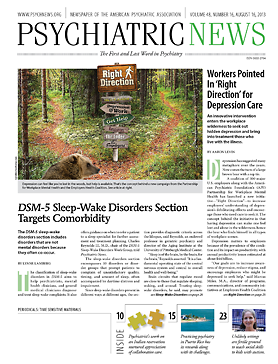A program of court-mandated assisted outpatient treatment (AOT) in New York appears to reduce the costs allocated for mental health services, according to a study posted online in AJP in Advance July 30.
The reduction in costs reflected fewer repeated episodes of expensive inpatient psychiatric treatment as patients instead received outpatient care and appropriate medications, said Jeffery Swanson, Ph.D., a professor of psychiatry and behavioral sciences at Duke University, and colleagues.
“Cost is important,” said Swanson in an interview with Psychiatric News. “Even if people conclude that there is some benefit to outpatient treatment, it doesn’t seal the deal if it’s too costly.”
Cost was just one issue that led to the current research by Swanson’s group. The first version of New York’s AOT law (often referred to as “Kendra’s Law”) was passed in 1999 and included a provision for evaluation by the state’s Office of Mental Health. That assessment of the law’s impact was positive but “fiercely contested,” in Swanson’s words, by those concerned either with its possible expense to the state or by civil libertarians who argued that the mandated treatment was overly coercive to patients.
That controversy led to a legislative requirement for an independent evaluation when the law was reauthorized in 2005. The task was assigned to a consortium of researchers led by Swanson and colleagues from Duke, the Policy Research Associates in Delmar, N.Y., Harvard Medical School, and the University of Virginia. Additional funding was provided by the MacArthur Foundation.
The study compared a sample of 520 AOT participants in New York City and 114 from Albany, Erie, Monroe, Nassau, and Rensselaer counties with 255 voluntary users of intensive community-based treatment in the same areas. The AOT patients had to be at least 18 years old, unable to live safely in the community, and with a history of violence and at least two recent hospitalizations or incarcerations.
“The vast majority of AOT patients receive their order when in involuntary treatment, and it gets them into [outpatient] treatment,” added Swanson’s colleague Marvin Swartz, M.D., also a professor of psychiatry and behavioral sciences at Duke.
After patients started AOT, hospitalizations decreased, while use of case management, assertive community treatment, other outpatient services, and psychotropic prescription fills increased, they noted.
On average, annual costs per patient in the New York City sample declined from $104,753 to $52,386 in the second year after discharge to AOT. Average annual costs in the other counties fell from $104,284 to $39,142.
“The costs of AOT are an investment,” Swanson told Psychiatric News. “The state spends less, and the savings can be reallocated across systems.”
Concerns that services for voluntary patients would be crowded out when resources were shifted to AOT participants proved true only in the short run, he said. Thanks to the state’s allocation of an additional $35 million to expand capacity, service access for both groups eventually equalized.
Those added resources are critical if an AOT system is to work properly, said Swartz. New York will have to maintain that financial commitment to continue the same level of services. Other states contemplating a similar approach to mandated outpatient treatment will have to commit to similar levels of support to make AOT effective.

